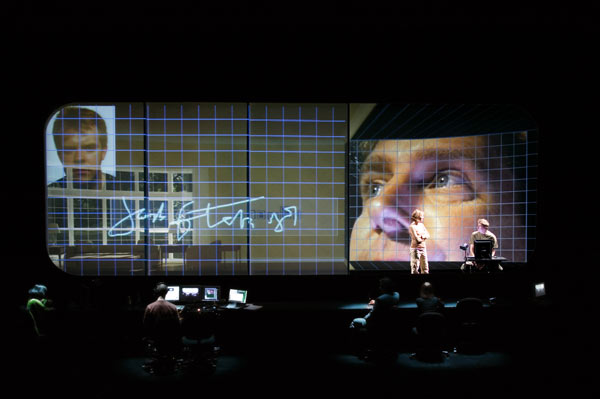The Builders Association and dbox, SUPER VISION: ARCHITECTURE
SUPER VISION tells three stories
1. As he crosses successive borders, a solitary traveller gradually is forced to reveal all of his personal information, until his identity becomes transparent, with no part of his life left outside the boundaries of datasurveillance.
2. A young woman (Jen), addicted to the white noise of constant connection, maintains a long-distance relationship with her Grandmother. As she makes efforts to digitally archive her Grandmother's past, the Grandmother slips into senility.
3. A father covertly exploits his young son's personal data to meet the demands of the family's lifestyle. This ploy escalates beyond the father's control, until he is compelled to disappear. His wife and son are left with a starkly diminished data portrait, and his escape is shadowed by the long reach of the datasphere.
Marianne Weems
Nick Kaye: The other thing that I wanted to ask about is architecture. You have worked now with at least two architectural partnerships or groups, dbox and, in JET LAG, Diller + Scofidio. Why architecture?
Marianne Weems: Stewart Laing is really the first set designer I have worked with. In the 80s, there was this whole rhetoric that had sprung up about a kind of architecture that was beyond building. In fact, it had very little to do with actual buildings and much more to do with bodies and the perception and manipulation of space and how space is a system that is ideologically configured. So that was really where my interests started. So with MASTER BUILDER (1994) - have you ever seen any pictures of that?
Nick Kaye: Yes, I have a tape that you gave me with a short extract -
Marianne Weems: Well, it truly was a ton of work – our designer John Cleater (and many others) built a three-story house. But it was an endless delight for me, staging people in that actual house. It was a dream-like, super-voyeuristic experience. And the house was lined with video and sound triggers which the actors activated. After that, and in each succeeding project since then, my interest in physical edifices has receded, and what has emerged is the interest in the electronic network and how that too is a kind of architecture. And how staging people can have architectural resonances as well. So what is your theory about architecture?
Nick Kaye: Well, architecture seems somehow to relate to this idea of rhythmic structure. Architecture creates spaces for other things to be in. Architecture can also be spatially multiple and multiple in its use.
Marianne Weems: Yes that’s right – that is a great point.

Left to right: image of John Fletcher Jr. (Allen Hahn), Kyle deCamp (Carol), David Pence (John Fletcher Sr.) onstage and mediated live.
Photo by dbox.
see also: narrative architecture | projection | the 'crush' scene | the family room | virtual spaces |
SUPER VISION credits




